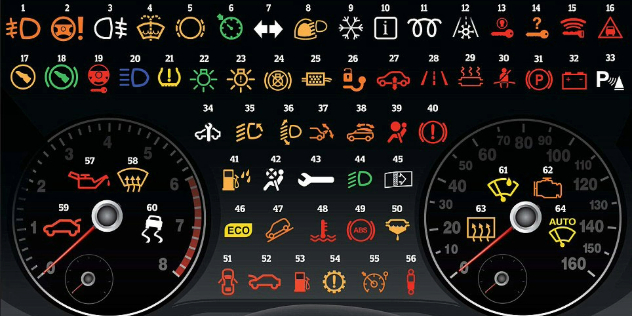What do dashboard warning lights in my car mean?

- A red warning light on the instrument panel indicates a serious car problem or a safety issue and should be checked straightaway
- The cause of an orange warning light should be checked as soon as you're able
- Consult the owner’s manual for explanation
The electronic systems in today's cars rely on a series of sensors connected to warning lights and symbols on the dashboard. Read on to see the most common dashboard warning lights and what they mean.
There are two main types of dashboard warning lights: red and orange. A red warning light generally indicates a serious issue with your car. You should act quickly if your dashboard warning light is red – it could be an overheating engine, low engine oil pressure or a braking system problem.
An orange dashboard warning light means the engine management system – the computer that runs the engine – has detected a fault. You may continue to drive a car with an orange dashboard warning light, but you should head to your local service centre for diagnosis and repair as soon as possible.
Related: Getting your car road trip ready
What should I do if a dashboard warning light comes in my car?
It’s important to pay attention to car dashboard warning lights because they can help you avoid a car breakdown, keep you safe on the road and potentially save you an expensive repair bill.
If a red or orange warning light appears on your dashboard, don’t ignore it. Instead, pull over somewhere safe and look up what it means in your owner’s manual. If you’re not sure what the problem is, ask a qualified mechanic or vehicle manufacturer for advice.
If a light momentarily illuminates then disappears, there may not be a problem, but it is a good idea to get it checked out by our mobile mechanics for peace of mind.
What are the most common car dashboard warning lights?

-
Fog light (front)
-
Power steering warning light
-
Fog light (rear)
-
Washer fluid low
-
Brake pad warning
-
Cruise control on
-
Direction indicators
-
Rain and light sensor
-
Winter mode
-
Information indicator
-
Glow plug/diesel pre-heat warning
-
Frost warning
-
Ignition switch warning
-
Key not in vehicle
-
Key fob battery low
-
Distance warning
-
Press clutch pedal
-
Press brake pedal
-
Steering lock warning
-
Main beam headlights
-
Tyre pressure low
-
Sidelight information
-
Exterior light fault
-
Brake lights warning
-
Diesel particulate filter warning
-
Trailer tow hitch warning
-
Air suspension warning
-
Lane departure warning
-
Catalytic converter warning
-
Seat belt not on
-
Parking brake light
-
Battery/alternator warning
-
Parking assist
-
Service required
-
Adaptive lighting
-
Headlight range control
-
Rear spoiler warning
-
Convertible roof warning
-
Airbag warning
-
Handbrake warning
-
Water in filter
-
Airbag deactivated
-
Fault problem
-
Dipped beam headlights
-
Dirty air filter
-
Eco driving indicator
-
Hill descent control
-
Temperature warning
-
ABS warning
-
Fuel filter warning
-
Door open
-
Bonnet open
-
Low fuel
-
Automatic gearbox warning
-
Speed limiter
-
Suspension dampers
-
Oil pressure low
-
Windscreen defrost
-
Boot open
-
Stability control off
-
Rain sensor
-
Engine/emissions warning
-
Rear window defrost
-
Auto windscreen wiping
Stay safe on the roads and catch any issues as soon as possible, if you are unsure it's always safer to ask a professional.
How do I reset my dashboard warning lights?
While DIY engine code scanners are available, simply removing persistent dashboard warning lights only treats the symptom and not the cause.
Your car has been built with sensors to identify faults that range from mild to potentially catastrophic, so if you find a dashboard warning light keeps returning, it is likely indicative of a larger problem.
Our mobile mechanics can repair electrical systems and clear engine codes on most makes, including Toyota and Mazda dashboard warning lights.






